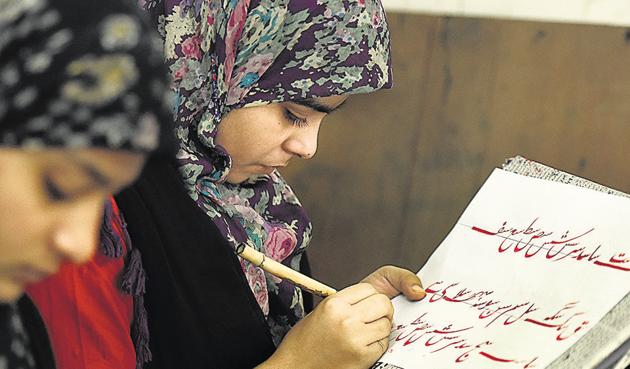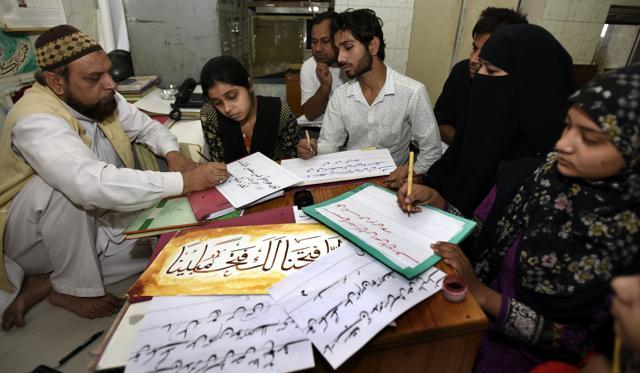Urdu publications shifted to printing but calligraphy hasn’t lost its charm
Urdu newspapers, books and magazines may have shifted to computerized printing, but the art of calligraphy hasn’t lost its charm.
Urdu newspapers, books and magazines may have shifted to computerized printing, but the art of calligraphy hasn’t lost its charm. College students and young professionals, who are in the printing or designing business, are learning the art sometimes as a hobby and at other times just to ‘evolve their thought process’.

The youngsters at the Urdu Academy in Kashmere Gate, set up in 1983, also aim to enhance their employment opportunities by learning the skill.
The art, however, gained traction after Urdu printing faced a shortage of calligraphers. Around six decades ago, there was acute shortage of calligraphers in the city. If an author wanted to get his book scripted by a skilled calligrapher, he had to wait for a year. “It was difficult to find a good kaatib or khattaat (calligrapher) then. There was no institution where one could learn the art,” said Waseem Ahmed, a calligraphy teacher at Urdu Academy. This was the time before the computer revolution.
The printing of Urdu, Arabic, or Persian manuscripts was solely dependent on the calligrapher. The entire text was handwritten and composed manually. The number of calligraphers was dwindling but the demand was high. To meet this demand-supply gap a centre to produce quality calligraphers was set up at Ghalib Academy in Nizamuddin in 1974. The grant for the institution came from Taraqqi Urdu Board (TUB), a government body, now known as the National Council for Promotion of Urdu Language (NCPUL).

Though, the institution at Nizamuddin was shut down in 2002, the Urdu Academy has been churning out young calligraphers. Around 12 students pass out from this centre every year. The centre runs a two-year diploma course with 25 students.
Mostly, young enthusiasts apply for admission, which is based on a simple Urdu writing test and an interview. Minimum qualification for the course is matriculation. Selected candidates are provided a scholarship of Rs500 per month which is linked to their attendance. To avail the scholarship, 75% attendance is compulsory.
“Presently, two batches of 25 students at Urdu Academy suffice to counter the popular perception that the traditional art form has lost its relevance or does not appeal to many any longer. We get students from different places and with different ideas in mind,” Ahmed said.
Huma Rafique, a government school teacher, enrolled herself in khattaati training programme at Urdu Academy in August with no specific goal. Rafique just wanted to learn the traditional form of writing as she had always been attracted to it. After three months of coaching, she now has a strong reason for coming to the class every day.
“After joining the training programme, I realised most people make fundamental mistakes when writing Urdu. I also observed that even teachers’ script is not correct. I wondered how one can teach a child to write an alphabets properly, if s/he doesn’t know the basics of lettering?” said Rafique, who did BEd and MPhil from Delhi University.
- With the advent of Urdu fonts, a paradigm shift took place in Urdu printing business and people started preferring computers over traditional ‘writers’
- As a result, the role of calligraphers was reduced
- In 1999, the Urdu Taraqqi Board stopped giving grants to the Urdu Academy
- Since then, the Delhi government has been managing on its own
- The centre at Ghalib Academy was shut down in 2002
- Around the same time, NCPUL started a calligraphy centre at Welcome in east Delhi. The council set up another institute in Mustafabad in 2009. The institute has given a fresh life to the art
- Anis Siddiqui, a calligrapher and guest faculty at Jamia Millia Islamia said establishing calligraphy centres was a conscious decision to save Urdu magazines and newspapers
- Suhail Khan, who runs a training centre at Mustafabad, said: "People have interest in the art form and are very keen. It is very much appreciated in foreign countries and there are a lot of avenues to be explored. Sadly, our students often struggle after completing the course. The govt or the nodal agency should find out a solution for this. We need to host workshops..."
“This course would enable me to tell students about the accurate formation of alphabets,” she said.
Her classmate, Mohammad Sameer, has not yet decided how he will make the most of the diploma but said if he becomes a teacher, the additional qualification will help find a better job and also in acquiring ‘more knowledge’.
“There are several rare books which are not easily readable because of their ancient writing style. I hope after this course, I would be able to read those manuscripts. It will help me acquire more knowledge. And I strongly believe any information never goes waste. I would certainly benefit from this,” he said.
“It is not correct to say that calligraphy is a dying art given the enthusiasm seen among the youth. However, we need to preserve and promote it,” concludes Ahmed.
Stay updated with all top Cities including, Bengaluru, Delhi, Mumbai and more across India. Stay informed on the latest happenings in World News along with Delhi Election 2025 and Delhi Election Result 2025 Live, New Delhi Election Result Live, Kalkaji Election Result Live at Hindustan Times.
Stay updated with all top Cities including, Bengaluru, Delhi, Mumbai and more across India. Stay informed on the latest happenings in World News along with Delhi Election 2025 and Delhi Election Result 2025 Live, New Delhi Election Result Live, Kalkaji Election Result Live at Hindustan Times.





